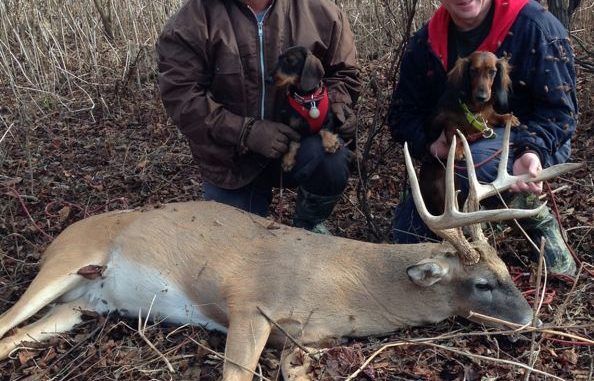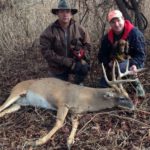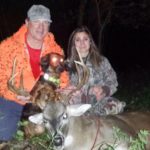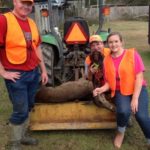
Guerin, Shrader provide tracking services free of charge
By now, Cliff Shrader and Andre Guerin are used to the skeptical looks they get from hunters when they show up to help locate a lost deer.
Amidst all the four-wheelers, pickup trucks, rifles, bows, arrows and camo, their tracking dogs don’t exactly fit into the manly atmosphere common at many deer camps.
“When Cliff shows up, those guys are like, ‘Are you serious?’” Guerin said with a laugh. “They’re like, ‘Why are you bringing that thing over here?’ And he’ll say, ‘I’ll make a deal with you. If I find that deer, you have to take a picture of that deer with this dog.’
“And they all happily do it.”
Shrader’s tracking dog is Tasha, a 2-year-old long-haired Dachshund. Guerin’s dog is Alleah, a wire-haired Dachshund just over a year old, and the two animals look like they’d be more at home sitting in your lap chewing a squeaky toy or watching TV than tracking bucks through the woods and swamps of Louisiana and Mississippi.
But that’s exactly what they do, and the two men and their tracking wiener dogs enjoy the thrill of the hunt that finding a lost deer provides.
“Down south, we don’t see a whole lot of Dachshunds tracking,” said Shrader, 55, who works at the Exxon Refinery in Baton Rouge. “Mostly around here you’ll see a lot of Labs tracking and you’ll see some mixed breeds tracking. Down here people don’t think about Dachshunds being hunting dogs at all.”
In fact, Dachshunds were originally bred in Germany to hunt and track scents, and their body type was developed to be long and low to the ground so they could fit into badger dens. While a man’s nose might have 5,000,000 “smelling” cells, a Dachshund has about 125,000,000.
“It just blew my mind the way this Dachshund tracks,” said Guerin, 46, an electrical superintendent from Ventress. “It’s ungodly.”
The men, who are brothers-in-law, have been hunting buddies for 15 years and started tracking together about a year ago.
Both have numerous stories and pictures detailing their adventures with Tasha and Alleah and all the deer they’ve recovered.
Depending on where a deer is lost and in what weather conditions, the men have been known to drive several hours to give their dogs the opportunity to track.
And they provide their services to everyone free of charge.
“We don’t charge anything. We do it for free,” Guerin said. “It’s all to let these dogs run. These dogs love what they do, and the more you take ‘em, the happier they are.
“This is just a lot more fun to me. I don’t have to sit in a cold deer stand. I don’t have to clean the deer. And every time we track, these people offer me deer meat on top of deer meat. Plus if we find it, I don’t even have to drag it out.”
Shrader said the opportunity to work with his dog, and also enjoy the company of the hunters whose deer he is tracking, is rewarding, especially when the deer is ultimately located.
“The other night I got a call from a guy in Clinton and went out and tracked the deer,” Shrader said. “I felt like I was hunting with him all evening. So I got to go on a hunt when I was at home just doing housework.”
Shrader’s dog came directly from Denmark, while Guerin’s came from Utah. A big key to the dogs’ tracking success is their ability to detect a chemical released through the hooves of wounded deer, Shrader said.
“It’s like when you secrete adrenaline when you’re scared,” Shrader said. “A deer does something similar. There’s a gland up on their leg that lets out a scent between their hooves.”
So when the blood trail ends, the dogs keep tracking, which is especially important on some gut shots, Shrader said.
“With a gut shot, the gut plugs up the hole and there’s no blood to follow. Of if you find blood, it’s just a little bit here and a little bit there and you might go 50 or 100 yards with no blood,” Shrader said. “But that dog can smell that gut scent, and they seem to track that better than anything.”
Guerin said when someone calls about a lost deer, they’ve developed a list of basic questions to help determine if the track has potential, including if blood has been found, if hair has been found, if the deer fell, wobbled or ran off, if it was shot with a rifle or a bow, and how much time already has been spent trying to track the deer.
The longer someone unsuccessfully searches and the further they go, the more difficulty the dogs might have in picking up the scent, he said.
“If you get a bunch of people that go tromping through the woods, they’ll step in blood that they can’t see and they’ll track blood all over the woods and throw the dog off,” he said. “The dogs will go in circles.”
When he gets a call and heads out for a track, Guerin places a special collar on Alleah that she only wears while she works.
“When you put that collar on her, she’s at the door,” he said. “She knows it’s business. That’s just the way they’re trained. She associates that collar with work all day long.”
Both men readily recount tales where the dogs invariably start following a scent, only to be told by the hunter there’s no possible way the deer headed that way.
Usually, the dogs’ noses know better.
Guerin told the story of a recent buck Alleah found floating along a river bank after about a 30-minute track on Three Rivers Wildlife Management Area.
“Those guys had looked for that deer for four hours,” Guerin said. “He told me, ‘I’d have never believed in a million years that dog would have found that deer. We’d have never found him without that dog.’”
Shrader shared the story of a track near Pine Grove last year, where Tasha started out hesitantly but ultimately found a buck in an overgrown area that had already been searched by several hunters.
“They said, ‘Man, all three of us looked all through here,’” Shrader said. “‘We’d have bet a paycheck that deer wasn’t within a hundred yards of where that dog was looking.’”
When they go out on a track together, Guerin and Shrader have learned to let the dogs work separately, allowing one to move further ahead on the trail while one works from behind.
“We can’t run the dogs together. They’re competitors,” Guerin said. “They both want to get to the deer at the same time.”
Following behind on 30-foot leashes, both men are astounded by their dogs almost every time they go out.
“It’s just amazing to watch these dogs track,”Guerin said. “They’re so short, they can get under barbed-wire fences and they can go through briars easier.”
But when they do find a deer, their normally friendly demeanor changes and they can get a little possessive, Guerin said.
“Any stranger can come up and love on these dogs. They’ll never bite or growl or nothing,” he said. “But when they find a deer, Cliff can’t pick up my dog and I don’t think I can pick up his.
“It’s their deer and they don’t want anybody else around.”
To watch a brief video of Tasha as she discovers a doe, click here.
The men work with the dogs in the offseason and lay out “training tracks” using blood and hooves from deer that ran off before they died.
“If there’s a shot at finding the deer, I think they’re going to find it most of the time,” Shrader said, noting that when they set off on a track they have no way of knowing if the deer they’re looking for ever actually died. “We have about a 70- or 75-percent success rate, but we don’t know the actual number of recoverable deer we go out on. Our percentage might be even higher.”
The good news for Shrader and Guerin is, whether they locate a missing deer or not, both Dachshunds are happy as family pets.
“They’re house dogs,” Guerin said. “Alleah sleeps under the covers at my feet every night.”
To contract Andre Guerin about tracking a deer, call his cell at 225-240-3922. For Cliff Shrader, call his cell at 225-802-1957.
For other trackers available in the area, visit www.southernbloodtracker.com by clicking here.





